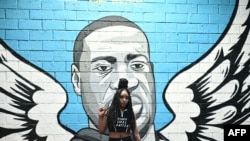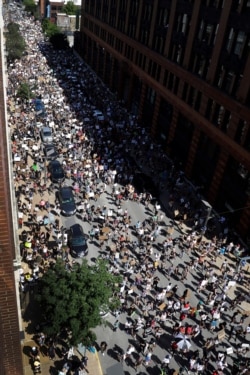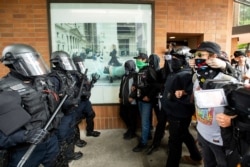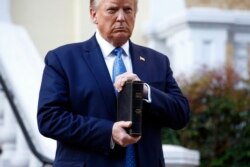As U.S. protests continue over the death of George Floyd, Chinese news outlets have focused their coverage on the unrest and looting, but those activities are only part of the story, experts say.
Since Floyd, a 46-year-old black man, died in police custody in Minneapolis on May 25, protests calling for racial justice and an end to police brutality have spread to more than 430 cities in all 50 states and the District of Columbia in the U.S.
China’s tightly controlled state media has mostly focused on a narrative favored by the country’s Communist Party leaders, namely that protests equal chaos.
Xijin Hu, is a Chinese journalist and editor of the Global Times, the Chinese government-run newspaper. He recently posted on his Weibo, the Chinese equivalent of Twitter, "In the eyes of most Chinese netizens, the current turmoil in the United States is the ‘reward’ of politicians who support the unrest in Hong Kong, … who themselves are now in the same trouble, and plain Chinese netizens feel relieved and think they ‘deserve it.’”
But the Chinese media focus on looting and violence is one-dimensional, observers say.
Robert Daly, director of the Wilson Center’s Kissinger Institute on China and the United States, said that the reason why the Chinese news coverage focuses on the unrest during the protests is, in part, because the definition of “chaos” is different in Chinese culture than it is in the U.S.
In the U.S., the Merriam-Webster dictionary defines chaos as “a state of utter confusion.” In China, while the dictionary definition may be much the same, the cultural perception of chaos is different. The government considers any opinion or action countering it as chaotic and encourages citizens to social and economic stability is more important.
"Generally speaking, [the Chinese] are very afraid of chaos,” said Daly who spoke with VOA in Chinese. “At home, many Chinese feel that they face a binary choice — either enjoy stability and gradual economic development under the Communist Party’s dictatorship, or the world will be chaotic. … While Americans don’t see it as a binary choice. Our definition of ‘chaos’ is not the same. We are not afraid.”
From the perspective of the Chinese Communist Party and Chinese culture, these protests might be viewed as entirely negative, but to most Americans, they are a sign of a healthy and free democracy.
“I'm not saying that America is perfect, that America has done nothing wrong, that it has done nothing unjustly, but at least all Americans value their freedom of speech and their ability to discuss these issues,” said Daly. “They, both on the left and the right don’t agree don't agree on many things, but they all value their freedom of speech. At the very least, we can all argue our views, and we can convince each other, so that the United States can be its own psychiatrist more effectively.”
Gene Policinski, the president of Freedom Forum Institute, said that the protests emphasize the American tradition of speaking up when the nation faces a serious problem, and should not be overshadowed by the dramatic pictures that highlight the violent acts of a relatively few people. The institute’s mission is to raise “awareness of First Amendment freedoms through education, advocacy and action, sharing the stories of Americans who have exercised their rights to ignite change.”
“[The protests] very much echo what is a very common American trend, when we have a serious problem in this nation,” Policinski told VOA Mandarin. “We feel the urge to speak out and we're powered by the First Amendment's protection for free speech, but also of assembly and petition which is the right to ask the government for change.”
“So if you go back to the very beginning — the Boston Tea Party, the protests in the colonial period ... Americans have a tradition of going public when they think their government is wrong or they think our society is wrong,” Policinski added. “So they're very much in that tradition.” The Boston Tea Party, a political protest, took place in 1773, at a wharf in Boston, Massachusetts. Americans were angry at Britain for imposing taxes on them, its colonial subjects, without giving them a voice in Parliament. The Americans dumped more than 300 chests of imported tea into the harbor. The event was the first major act of defiance to British rule, according to History.com.
The First Amendment guarantees “freedoms concerning religion, expression, assembly, and the right to petition. It forbids Congress from both promoting one religion over others and also restricting an individual’s religious practices. It guarantees freedom of expression by prohibiting Congress from restricting the press or the rights of individuals to speak freely. It also guarantees the right of citizens to assemble peaceably and to petition their government, according to the Legal Information Institute at Cornell Law School.
Legal experts stress that the First Amendment protects only peaceful protests, not violence, looting and property destruction. Law enforcement officers at the scene of any protest are there to defend the people's right to protest. They are also there to maintain order and security.
But finding a balance between the two is difficult. Critics of President Donald Trump complained last week that he deployed police and the military to impose order and clear the way for a photo op at a church near the White House while thwarting the protesters the right to assemble and protest.
Timothy Zick, a professor at William and Mary Law School where he teaches courses on constitutional law and the First Amendment, told VOA that there have been major reforms in police tactics for controlling crowds over the years since protests against the Vietnam War in the 1960s when police used aggressive, escalating force to break up demonstrations.
“Most police forces have moved on from that and have engaged in more managerial methods, talking to protesters in advance, trying to understand what they want to accomplish, where they want to protest and managing dissent in that way,” he said.
Adrianna Zhang contributed to this report









